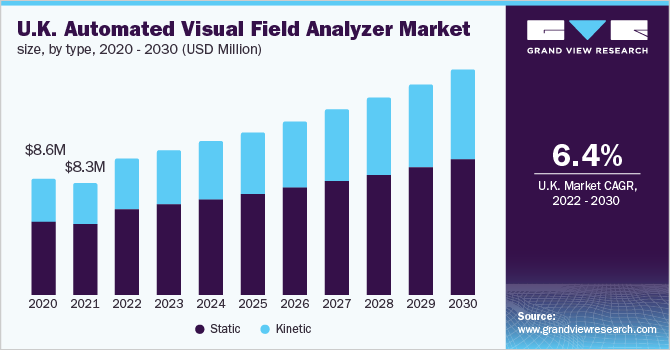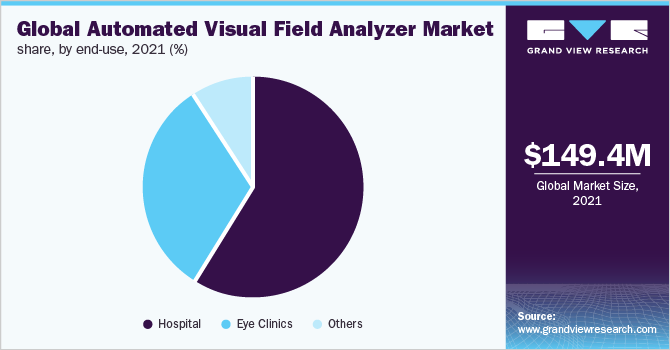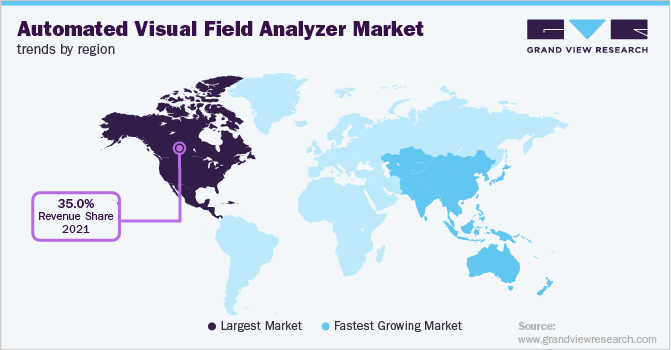- Home
- »
- Medical Devices
- »
-
Automated Visual Field Analyzer Market Report, 2022-2030GVR Report cover
![Automated Visual Field Analyzer Market Size, Share & Trends Report]()
Automated Visual Field Analyzer Market Size, Share & Trends Analysis Report By Type (Static, Kinetic), By Application (Glaucoma, Age-related Macular Degeneration), By End-use, By Region, And Segment Forecasts, 2022 - 2030
- Report ID: GVR-4-68038-301-0
- Number of Pages: 120
- Format: Electronic (PDF)
- Historical Range: 2017 - 2020
- Industry: Healthcare
Report Overview
The global automated visual field analyzer market size was valued at USD 149.38 million in 2021 and is expected to expand at a compound annual growth rate (CAGR) of 6.52% from 2022 to 2030. The automated visual field plays a vital role in the prevention and early detection of ocular diseases by assessing the visual field of the human eyes. Aging is the primary risk factor for most eye conditions. Thus, an increase in the prevalence of ocular disorders, such as glaucoma, cataract, and diabetic retinopathy, a growing geriatric population, and the introduction of a technologically advanced automated visual field analyzer for diagnosis have fueled the market growth. The number of people with glaucoma, an age-related eye condition, is projected to increase 1.3 times between 2020 (76 million) and 2030 (95.4 million).

The turnaround time for automated visual field analyzers has greatly decreased and accuracy in visual field testing has increased. New software algorithms have been introduced, which is one of these significant advancements. An increase in the frequency of new product launches is one of the main factors projected to fuel the market expansion. Recent technical developments are leading to the creation of novel visual function tests. The examination of the patient population with restricted access to healthcare is now made possible by diagnostic testing employing portable, affordable equipment, which also allows testing to take place outside of a clinical setting or at home.
The number of people with visual impairment and blindness is anticipated to rise significantly as a result of COVID-19's global effects on eye health, population aging, environmental changes, and lifestyle shifts. Globally, there are at least 2.2 billion people who struggle with near or far vision. However, Covid-19 has had a negative effect on the market for automated visual field analyzers due to factors such as the postponement of elective hospital treatments, including eye exams, and the risk of infection, which has caused a decrease in the number of people visiting eye clinics. The market is also being constrained by factors like a lack of ophthalmologists, price pressure, rising competition, and excessive costs.
The automated visual field analyzer has clear benefits over the manual visual field analyzer as it delivers more sensitive and accurate findings promptly, and the recording of patient responses can be regulated, resulting in more reliable results. The introduction of automated analyzers and compact portable analyzers is expected to be one of the prominent factors driving the market. For instance, in December 2018, Micro Medical Devices launched its visual field analyzer branded as PalmScan VF200. The device is a battery-powered portable device that allows users to perform screening and complete threshold visual field tests on patients in any setting including an office waiting room, a nursing home, or even the patient's own house.
Moreover, the high prevalence of ophthalmic diseases in the Asia Pacific is expected to create high demand for automated visual field analyzers. According to the WHO, three Asian areas alone (containing 51% of the global population) account for 62% of the estimated 216.6 million people worldwide with moderate to severe bilateral exhibiting distance vision impairment: South Asia (61.2 million), East Asia (52.9 million), and South-East Asia (52.9 million) (20.8 million).
Furthermore, to spread awareness regarding eye health and vision care among the general public, optometrists, and ophthalmologists for the diagnosis and treatment of ophthalmic diseases, many organizations are taking several initiatives. Some of these activities include conducting awareness and advertising campaigns and workshops. Additionally, several providers offer seminars, tutorials, and workshops that give ophthalmologists and technicians practical training with visual field analyzers. Such initiatives help to increase awareness regarding eye diseases and readily available diagnostic tools like ophthalmic perimeters, which will fuel the industry's growth.
Type Insights
Static automated visual field analyzer dominated the market with over 60.0% share in 2021. The static perimeter is the most preferred method for assessing visual field quality, detecting glaucoma, and monitoring glaucoma-related changes in the visual field. The outcomes of this exam are strongly influenced by the test taker. For that reason, it is usually done twice, and often three times, in a single session. Furthermore, the effective use of the static perimeter for visual field testing in glaucoma-affected children is expected to stimulate the growth of the segment.
The kinetic visual field analyzer segment is anticipated to exhibit the fastest growth rate of 7.27% during the forecast period. Some of the major advantages of kinetic visual field analyzers include their capacity to catch moving stimuli and provide accurate findings. Their primary benefits are improved spatial resolution, quicker peripheral testing, and even more interaction between the examiner and the patient.
Application Insights
In 2021, the glaucoma segment held the largest revenue share of over 35.0%. Glaucoma impairs the eye's optic nerve and causes blindness and vision loss. The normal fluid pressure inside of the eyes gradually rising causes glaucoma. Since it is a chronic condition that progresses slowly over time without the patient noticing vision loss until the sickness is advanced, the condition is known as a "sneak thief of sight." Due to the increasing prevalence of glaucoma and the fact that it is one of the main causes of blindness, the glaucoma segment is dominating the market. In 2020, the Bright Focus Foundation estimated that 20 million people worldwide had glaucoma. By the end of 2040, this number is anticipated to approach 111 million.
Age-related macular degeneration (AMD) is anticipated to expand at the fastest rate during the projected period. This is explained by the rising number of geriatric people, who are quite prone to develop this condition. For instance, the CDC reports that age-related macular degeneration is the main reason why Americans over 65 lose their eyesight and become blind. According to the aforementioned source, it is anticipated that by 2050, there would be 88 million elder Americans, nearly doubling from 48 million.
End-use Insights
The hospital's segment held the largest revenue share of over 55.0% in 2021. The rising incidence of eye-related conditions and the technological advancements in the automated visual field analyzer are driving the segment. The increasing mergers and acquisitions between ophthalmic non-profit organizations and hospitals are likely to boost demand for new installations in the coming years. Moreover, favorable reimbursement policies in developed countries and improving healthcare facilities are factors contributing to the segment growth.

The eye clinics segment is expected to expand at the fastest CAGR of 7.29% over the forecast period owing to factors such as the growing patient population with ocular diseases and the expanding need for ophthalmic care, which is providing an opportunity for ophthalmologists and optometrists to provide individual services. Furthermore, increased access to modern ophthalmology technology in ophthalmic clinics in various underserved countries, growing awareness regarding eye-related disorders, and the contribution of non-profit organizations toward the development of ophthalmic care is projected to add to the growth of the market.
Regional Insights
North America dominated the market and accounted for a revenue share of over 35.0% in 2021. This can be attributed to the presence of many market players in the region and an increase in the prevalence of ophthalmic diseases. High adoption of the latest technologies and favorable reimbursement policies are the factors driving the market for automated visual field analyzers.

In the Asia Pacific, the market for automated visual field analyzers is expected to register the fastest growth rate during the forecast period. Fast developing economies and modernizing healthcare services in Southeast Asian countries are expected to drive the market in the region. The overall healthcare services charges in the region are significantly lower compared to the developed countries. This is encouraging the growth of medical tourism in the region, thus boosting the overall procedural volume in these countries. Furthermore, conferences, trade fairs, and seminars for ophthalmic care devices held in the Asia Pacific are assisting local businesses in gaining international recognition. This aids in researching the development and launch of advanced solutions in the field of ophthalmology.
Key Companies & Market Share Insights
The market is fragmented with the high competition at the global level as it has the presence of severe market players. These players focus on growth strategies, such as new product launches, collaborations, partnerships, operational expansion, mergers & acquisitions, and patient awareness campaigns. Moreover, many biopharmaceutical companies have been looking for a better mode of drug delivery for their portfolio of biologic drugs, for which wearable injectors are an appropriate solution. For instance, in July 2020, Topcon Healthcare acquired the Henson line of perimetry products. The acquired product range also includes Henson 9000 and 7000. In addition, Metrovision is working on a project named INVISIO aims to create new and interesting ways for assessing visual functions by combining photonics, auto stereoscopy, and eye tracking with applications in pediatric ophthalmology. Some prominent players in the global automated visual field analyzer market include:
-
Carl Zeiss
-
Haag-Streit AG
-
Elektron Eye Technology
-
Heidelberg Engineering
-
Kowa Company, Ltd.
-
Optopol
-
OCULUS
-
Metrovision
-
MEDA Co., Ltd.
-
Topcon
Automated Visual Field Analyzer Market Report Scope
Report Attribute
Details
Market size value in 2022
USD 181.10 million
Revenue forecast in 2030
USD 300.11 million
Growth rate
CAGR of 6.52% from 2022 to 2030
Base year for estimation
2021
Historical data
2017 - 2020
Forecast period
2022 - 2030
Quantitative units
Revenue in USD million and CAGR from 2022 to 2030
Report coverage
Revenue forecast, company ranking, competitive landscape, growth factors, and trends
Segments covered
Type, application, end-use, region
Regional scope
North America; Europe; Asia Pacific; Latin America; MEA
Country scope
U.S.; Canada; U.K.; Germany; France; Italy; Spain; Japan; India; China; Australia; South Korea; Brazil; Mexico; Argentina; Columbia; South Africa; Saudi Arabia; UAE
Key companies profiled
Carl Zeiss; Haag-Streit AG; Elektron Eye Technology; Heidelberg Engineering; Kowa Company, Ltd.; Optopol; OCULUS; Metrovision; MEDA Co., Ltd.; Topcon
Customization scope
Free report customization (equivalent to up to 8 analysts' working days) with purchase. Addition or alteration to country, regional & segment scope.
Pricing and purchase options
Avail of customized purchase options to meet your exact research needs. Explore purchase options
Global Automated Visual Field Analyzer Market
This report forecasts revenue growth at the global, regional, and country levels and provides an analysis of the latest industry trends and opportunities in each of the sub-segments from 2017 to 2030. For this study, Grand View Research has segmented the global automated visual field analyzer market report based on type, application, end-use, and region:

-
Type Outlook (Revenue, USD Million, 2017 - 2030)
-
Static
-
Kinetic
-
-
Application Outlook (Revenue, USD Million, 2017 - 2030)
-
Glaucoma
-
Age-related Macular Degeneration (AMD)
-
Scotoma
-
Others
-
-
End-use Outlook (Revenue, USD Million, 2017 - 2030)
-
Hospitals
-
Eye Clinics
-
Others
-
-
Regional Outlook (Revenue, USD Million, 2017 - 2030)
-
North America
-
U.S.
-
Canada
-
-
Europe
-
Germany
-
U.K.
-
France
-
Italy
-
Spain
-
-
Asia Pacific
-
China
-
Japan
-
India
-
Australia
-
South Korea
-
-
Latin America
-
Brazil
-
Mexico
-
Argentina
-
Colombia
-
-
Middle East & Africa
-
South Africa
-
Saudi Arabia
-
UAE
-
-
Frequently Asked Questions About This Report
b. The global automated visual field analyzer market is expected to grow at a compound annual growth rate of 6.52% from 2022 to 2030 to reach USD 300.11 million by 2030.
b. North America dominated the automated visual field analyzer market with a share of 35.11% in 2021. This is attributable to the high adoption of technologically advanced medical devices and the increasing demand for accurate devices.
b. Some key players operating in the automated visual field analyzer market include Carl Zeiss; Haag-Streit AG; Elektron Eye Technology; Heidelberg Engineering; Kowa Company, Ltd; Optopol; Topcon, and Metrovision.
b. Key factors that are driving the automated visual field analyzer market growth include technological advances and an increase in the frequency of new product launches. Additionally, the rise in the prevalence of ocular disorders such as cataracts and glaucoma is expected to drive the overall growth,
b. The global automated visual field analyzer market size was estimated at USD 149.38 million in 2021 and is expected to reach USD 181.10 million in 2022.
Share this report with your colleague or friend.
![gvr icn]()
NEED A CUSTOM REPORT?
We can customize every report - free of charge - including purchasing stand-alone sections or country-level reports, as well as offer affordable discounts for start-ups & universities. Contact us now
![Certified Icon]()
We are GDPR and CCPA compliant! Your transaction & personal information is safe and secure. For more details, please read our privacy policy.
We are committed towards customer satisfaction, and quality service.
"The quality of research they have done for us has been excellent."





